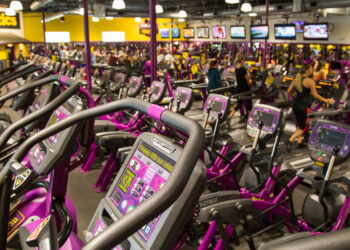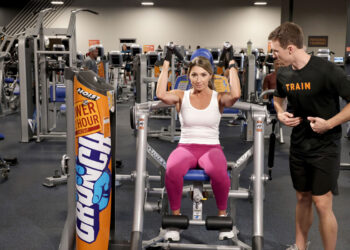 As the American public becomes increasingly aware of the long-term benefits of healthy living and fitness, more health club goers are in search of programs that foster better habits for all family members, including young children.
As the American public becomes increasingly aware of the long-term benefits of healthy living and fitness, more health club goers are in search of programs that foster better habits for all family members, including young children.
Health clubs are uniquely positioned to step up and assume the role of healthcare advocates for a generation of children threatened by the dangers of an inactive lifestyle—including obesity, type 2 diabetes and a host of other illnesses associated with being overweight, according to Phil Lawler, a retired Illinois Physical Education teacher and consultant for youth fitness group PE4Life. “We need to get health clubs involved in their communities and asking how they can contribute,” Lawler advises. “If somebody doesn’t step up and speak out for this generation of children, we’re going to be in trouble.”
With some education, a little training and a willingness to invest in programs that could increase customer satisfaction, retention and future membership, nearly any health club can add to its bottom line by expanding to offer health options for all ages.
Good for Kids, Good for Business
Youth fitness, if properly implemented, is a good idea for parents, children and a health club’s overall business outlook. Children who are sedentary, overweight or at risk for obesity stand to gain tremendously from developing healthy habits and an enthusiasm for activity at an early age. And parents who want to keep their kids active and are already gym members will be grateful for a chance to make the gym a fun trip for the whole family.
Keeping in mind a member’s entire family can be a great way to build a customer service reputation and set your club apart from the competition. Youth programming not only helps kids today, but sets them up to be tomorrow’s gym-goers, says Cheryl Jones, vice president of Programs and Services for Town Sports International, which offers numerous day camps, programs and activities for about 10,000 youths at 30 club locations. “The fitness club environment becomes familiar and comfortable to our youth participants, making the decision to become a fitness member an easy choice. They will be our future health club members,” she says. “Investing in the health of our children is an investment in our future.”
ClubSport Pleasanton in California offers motion classes for children as young as 2 and one half, according to Junior Programming Director Dina Weir. The offerings are part of a larger club philosophy, she explains. “Fitness needs to be a lifestyle for the whole family. By offering activities to the smaller children in our daycare, as well as junior group exercise classes for 9- to 12-year-olds, we allow the whole family to participate in a healthier lifestyle.”
Deciding on a Program
There’s no single recipe to follow for creating a fun, engaging and profitable youth fitness area at your club. You can decide whether fitness will come from interactive gaming systems or from machines specially designed to meet the needs of younger audiences. “You can do it with as few as a couple bikes or as little as a couple of jump ropes with some aerobic exercises in between,” says Adam Guier, national sales manager for the Commercial Division of Hoist Fitness, maker of a special line of selectorized equipment for youth.
Keeping in mind that children first need to be engaged and entertained before they will maintain an exercise routine, Hoist created a seven-piece series of strength equipment that offers a multiple-joint workout. Kids sit on a machine that corrects and maintains a safe posture, while experiencing a movement designed to mimic a ride. Other companies, like Strive Interactive Fitness, have created gaming areas designed to work specific muscle groups and keep kids interested. Expresso Fitness, maker of the S3 Youth Bike, believes kids are more eager to participate in exercise if a fun element is involved, according to Judy Barker, director of Product Marketing. Their bikes for children feature exergaming, where riders see themselves on a video screen in a racing or video game environment. “Playing” through a workout keeps kids motivated to complete an activity and come back for more. “In the Expresso Chase game, kids ride down coins and then score points by capturing dragons,” Barker explains. “The riders are so engaged in developing strategies to improve their scores they don’t really realize they are getting in a great workout—and they are motivated to come back the next time to see how they can improve their score.”
Ensuring Success
If you are considering incorporating a youth fitness element into your club’s list of services, you’ll need to learn more about the physical needs and abilities of children at different age levels, suggests Paul Rosengard, executive director of SPARK program, a Physical Education advocacy group. Once a child is in junior high school or middle school, he or she will likely be able to transition to adult workout areas at your club, but younger kids have different developmental needs. Children from 3 to 5, for example, should be playing with beanbags and soft, squishy toys, or manipulating body movements to imitate shapes and animals. From ages 5 to 7, kids should be working with partners or in small groups, learning to share toys and equipment while practicing fundamental movements like throwing, catching and kicking, according to Rosengard. Older kids, ages 8 to 11, can benefit from small, modified versions of sport activities, such as soccer with no goalies, where all players get multiple chances to play and try out basic moves.
Recruiting and hiring qualified, trained youth instructors is the best way to make sure your club adheres to the changing developmental needs of the youth it serves, Jones says. They can help to make sure activities remain safe and fun and will keep kids motivated and eager to return. This is also a great way to ensure that your club is making the most of the programs you choose to provide and will set you up for future gains. “Now you’ve got more health club members (and) you’re building a continuum for them that could last a lifetime,” Rosengard says of developing a successful program. “It adds a great value to the club, and it’s an additional source of revenue.” – CS
Sidebar:
Thinking of Starting A Youth Program?
Here are some ways to do your homework first and ensure future success!
1. Poll members to determine if your club has a family-based membership and also if the majority of the membership is kid-friendly.
2. Figure out if your main motivation for creating youth programming is for profit or to add value to the membership you offer. This decision should direct all planning, purchasing and long-term budgetary decisions.
3. Know your demographics, such as the percentage of children under 15 who live within a 10-minute driving radius to your facility, suggests Cheryl Jones, vice president of Programs and Services for Town Sports International. An indicator of success is if 15 percent or more of the population fits in this demographic range.
4. Identify areas in your club that would be available during prime time youth programming hours (after school and on weekends) and would minimize crossover between kids and adults.
5. Determine your program offerings. Programs that satisfy a family need, such as swim lessons and summer camps as an alternative to daycare, are an instant win, Jones says.
INDUSTRY RESOURCES:
Expresso Fitness
www.expresso.com
Hoist Fitness Systems
www.hoistfitness.com
PE4Life
www.PE4Life.org
SPARK
www.sparkpe.org








